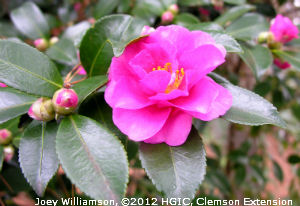
by Sheila Dunning | Nov 18, 2015
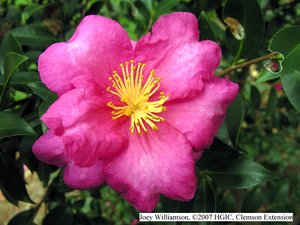
Camellia sasanqua ‘Kanjiro’ at the South Carolina Botanical Garden
Camellia sasanquas begin blooming this month. Their three-inch diameter blossoms of pink, white, rose or red displayed over glossy, dark green foliage will come into their full glory in November. This robust and stylish aristocrat of the garden is often passed by in favor of its familiar cousin, Camellia japonica. While it’s true that the “japonicas” have larger flowers, Camellia sasanqua has just as many endearing attributes. Like the japonicas, sasanquas have been selected and hybridized into dozens of forms that vary immensely in flower color, size and shape. With a variety of growth habits from dwarf and spreading to narrow and upright, their ability to thrive in part sun or shade, sasanquas are one of the most versatile landscape plants.
Sasanquas bear profusions of flowers in fall and early winter depending on cultivar and location. In general they blossom before Camellia japonica. Sasanquas have mature heights that range from 4-15 ft. The taller cultivars are typically trimmed up as small trees. Other cultivars remain shrubby and limited in height. Their small foliage makes them suitable subjects for formal pruning, although they are quite attractive when allowed to grow naturally. Several sasanqua varieties are ideal for creating dramatic espaliers when trained on fences and walls. Like other cool weather bloomers, sasanquas bloom over a much longer period than most spring and summer plants with buds opening over a three-month period. The blossoms shatter easily and create colorful carpets of petals on the ground, adding to their garden impact. Even when not in bloom the sasanquas make a statement with their beautifully glossy, rich green leaves that excel at providing backdrops for garden neighbors.

Camellia ‘Vernalis Yuletide’ at the South Carolina Botanical Garden

Camellia sasanqua ‘Shishi Gashira’ at the South Carolina Botanical Garden
Sasanqua camellias are native to China and Japan. They prefer rich organic acid soils (the same as azaleas and gardenias). Provide plants with organic mulch such as leaf litter or shredded bark. Broken shade is preferred but sasanquas will tolerate more sun if watered well. Consistent watering is important to continuous blooming. If the experience drought conditions the buds will dry and fall without opening.
Select sasanqua varieties based on what you want them to do in your garden. ‘Shishi-Gashira’ is a dwarf, low spreading plant that is suited well for foundation plants and container specimens. Other compact varieties include the more upright ‘Yuletide’ whose fiery red blossoms are accented with bright yellow stamens and the double rose ‘Bonanza’ which begins flowering in September with flowers that rival the japonica varieties in size and form. If you need larger and faster growing plants for hedges, screens or small specimen tree, consider the white ‘Snow on the Mountain’, double pink ‘Pink Snow’ or pale, shell pink ‘Jean May’. ‘Kanjiro’ and ‘Daydream’ are vigorous upright pink varieties whose single flowers are fragrant.
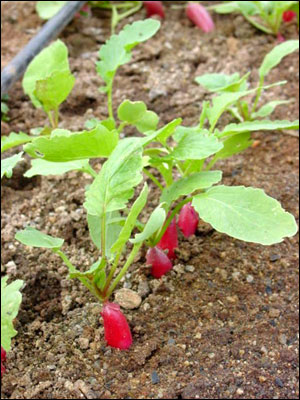
by Matthew Orwat | Nov 13, 2015

Radishes ready to harvest. Image Credit, UF / IFAS Gardening Solutions
Floridians are lucky, in that they are able to grow many vegetables throughout the winter months. If a fast growing, quick producing vegetable is desired, nothing is faster than a radish. Radishes can develop from seed to mature root in 20-30 days, and can be planted any time between September and March. The cooler months of October to February are even better since radishes do not develop the “hot” flavor when grown in cooler temperatures. There is less risk of that occurring during the cooler months of fall and winter.
Radishes should be direct seeded in the garden at a depth of 0.25 inches. They should be seeded 1 inch apart, with rows 6 inches apart. It is important that they not be crowded since the edible root portion will not form properly unless the plants are given plenty of space. Once plants emerge, thin them to about 3 inches apart.
At planting, plenty or organic matter and fertilizer should be incorporated in the bed. If soil is not well-drained garden in a raised bed. Avoid fertilizing once the seeds have germinated. Make sure to provide uniform irrigation and a weed free environment.
Harvest should take place when the radishes are ready (20-30 days), but fairly young to ensure a mild tasting root.
For more information consult Root Crop Production in Florida, part of the Florida Vegetable Production Handbook

by Matt Lollar | Nov 9, 2015
Next time  you are in the grocery store, consider purchasing an extra jar or two of peanut butter and donating it to your local Extension office as part of the annual Peanut Butter Challenge. The Challenge is a food collection drive of peanut butter from within each of the 16 UF/IFAS Extension Northwest District Counties. UF/IFAS Extension Northwest District agents have been partnering with the Florida Peanut Producers Association since 2012 to collect peanut butter and distribute the bounty to local food pantries in each county. Annually, Ken Barton and the Florida Peanut Producers Association Board of Directors provide an additional two pallets of peanut butter (approximately 2800 jars) to be divided between the counties. Not only does the Peanut Butter Challenge help publicize the important contribution of north Florida’s peanut growers to the peanut industry, but it also helps provide a healthy and universally loved product, made from a locally grown product, to food pantries in northwest Florida communities from Pensacola to Monticello.
you are in the grocery store, consider purchasing an extra jar or two of peanut butter and donating it to your local Extension office as part of the annual Peanut Butter Challenge. The Challenge is a food collection drive of peanut butter from within each of the 16 UF/IFAS Extension Northwest District Counties. UF/IFAS Extension Northwest District agents have been partnering with the Florida Peanut Producers Association since 2012 to collect peanut butter and distribute the bounty to local food pantries in each county. Annually, Ken Barton and the Florida Peanut Producers Association Board of Directors provide an additional two pallets of peanut butter (approximately 2800 jars) to be divided between the counties. Not only does the Peanut Butter Challenge help publicize the important contribution of north Florida’s peanut growers to the peanut industry, but it also helps provide a healthy and universally loved product, made from a locally grown product, to food pantries in northwest Florida communities from Pensacola to Monticello.
In 2014, Santa Rosa County collected 1477 jars resulting in more than a ton of peanut butter for their local food pantries. Escambia County was blessed by the support Helton Farms and Tri-County Peanut Buying Point. Rodney and Mike Helton and Tri-County purchased two additional pallets of peanut butter from Peanut Proud and helped to distribute to Escambia County Florida and Escambia and Baldwin counties in Alabama. In Washington County, the Public Library is doing a “Food for Fines” campaign, whereby patrons can bring in food in lieu of money for overdue fines. The library director is changing her campaign to require peanut butter donations as the food for fine forgiveness. They will collect peanut butter through November 30 and make a joint presentation with Extension to the local food bank.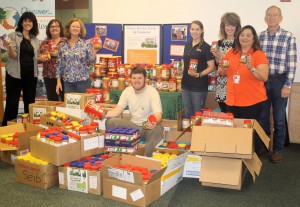
As you can see, there are many different ways to get involved. Across the panhandle, 3463 jars of peanut butter were donated in 2014, amounting to almost 5000 pounds of peanut butter. We’d really like to surpass that number, so please consider helping us by donating as many jars of peanut butter as you can afford. The collection continues to November 25, 2015. Contact your local Extension office to find out where you can drop off peanut butter.
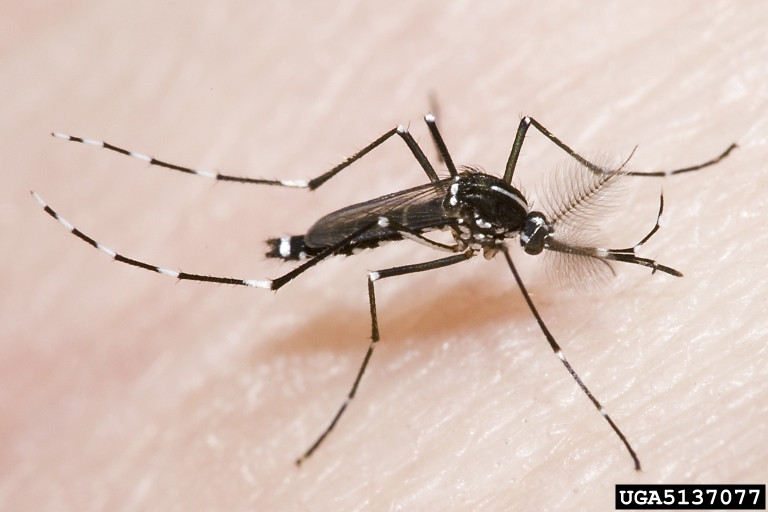
by Mary Salinas | Nov 9, 2015
Are you plagued with mosquitoes in your yard? Does it seem like you have a greater infestation than your neighbors? There may be some solutions to solve the problem other than using pesticides that negatively impact beneficial insects in your landscape.
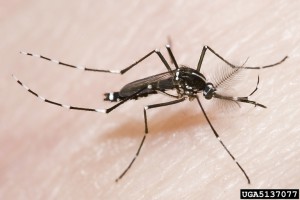
Asian tiger mosquito. Photo credit: Susan Ellis, Bugwood.org.
Mosquitoes are not only annoying, they can transmit serious diseases such as: eastern equine encephalitis, dengue fever, dog or cat heartworm, chikungunya, malaria, St. Louis encephalitis and west Nile virus.
Let’s first explore what kind of environment in your landscape and around your home is friendly to the proliferation of mosquitos. Adult mosquitoes lay their eggs on or very near water that is still or stagnant. That is because the larvae live in the water but have to come to the surface regularly to breeze. The small delicate larvae need the water surface to be still in order to surface and breathe. Water that is continually moving or flowing inhibits mosquito populations.
Look around your home and landscape for these possible sites of still water that can be excellent mosquito breeding grounds:
- bird baths
- potted plant saucers
- pet dishes
- old tires
- ponds
- roof gutters
- tarps over boats or recreational vehicles
- rain barrels (screen mesh over the opening will prevent females from laying their eggs)
- bromeliads (they hold water in their central cup or leaf axils)
- any other structure that will hold even a small amount of water (I even had them on a heating mat in a greenhouse that had very shallow puddles of water!)
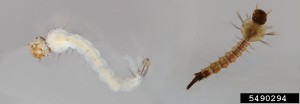
Mosquito larvae. Photo credit: Ari Farajollahi, Bugwood.org.
You may want to rid yourself of some of these sources of standing water or empty them every three to four days. What if you have bromeliads, a pond or some other standing water and you want to keep them and yet control mosquitoes? There is an environmentally responsible solution. Some bacteria, Bacillus thuringiensis ssp. israelensis or Bacillus sphaericus, only infects mosquitoes and other close relatives like gnats and blackflies and is harmless to all other organisms. Look for products on the market that contain this bacteria.
For more information:
UF/IFAS Mosquito Information Website
Biological Control of Mosquitoes
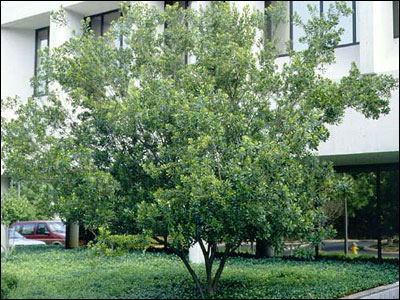
by Matthew Orwat | Nov 5, 2015

Waxmyrtle. Image Credit UF / IFAS Solutions
Myrica cerifera Southern Waxmyrtle, Bayberry is a large shrub to small tree that is now native to much of Florida and much of the Southeastern United States. It was introduced to Europeans in the 1700s and is considered native by many botanical authorities. Sources disagree to the validity of its native status. It is usually found as an understory plant in lightly forested areas, swamps, brackish areas, as well as around old home sites.
It was planted widely in the 18th,19th and early 20th century as a plant for medicinal and industrial purposes. Four pounds of its berries will yield one pound of wax for candle making. When processed, this wax was also used in surgeon’s soap, shaving lather, and sealing wax. Fermented leaves were used to produce a substance which was said to treat fever, stomach aches, and headaches.
Southern Waxmyrtle can reach up to 25 feet but is best maintained as a 10-20 foot multi-trunked shrub or small tree. It can also be trained as a smaller hedge and several dwarf form exist. Landscapes are enhanced by the shrubs’ olive green foliage, leaf aroma, open, rounded form and waxy blue-green berries. Wildlife enjoy the berries as a food source as well. They can provide dappled shade for outdoor entertainment spaces or front entrances.
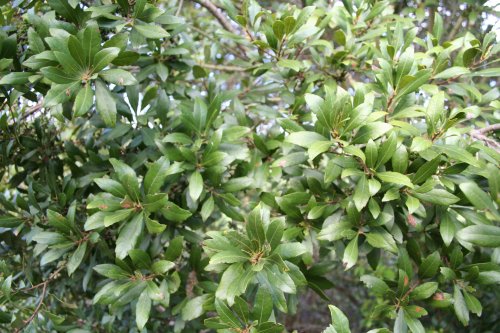
Waxmyrtle Leaves. Image Credit Brent Sellers – UF / IFAS Extension
Another benefit of Waxmyrtle is that it can be used in tough-to-landscape roadside and coastal areas since it is both pollution and salt tolerant and will cease to require irrigation once it is established. ‘Pumila’ is a dwarf cultivar suitable to small spaces.
Waxmyrtle is susceptible to few pests and diseases but can occasionally be attacked by webworms, mites and caterpillars. These can be controlled by pruning out of infested areas, forceful applications of water or Bt (Bacillus thuringiensis for caterpillar). It is also occasionally susceptible to canker on old branches and Fusarium wilt in central and south Florida. It is also considered a weed in pasture situations.
References:






 you are in the grocery store, consider purchasing an extra jar or two of peanut butter and donating it to your local Extension office as part of the annual Peanut Butter Challenge. The Challenge is a food collection drive of peanut butter from within each of the 16 UF/IFAS Extension Northwest District Counties. UF/IFAS Extension Northwest District agents have been partnering with the Florida Peanut Producers Association since 2012 to collect peanut butter and distribute the bounty to local food pantries in each county. Annually, Ken Barton and the Florida Peanut Producers Association Board of Directors provide an additional two pallets of peanut butter (approximately 2800 jars) to be divided between the counties. Not only does the Peanut Butter Challenge help publicize the important contribution of north Florida’s peanut growers to the peanut industry, but it also helps provide a healthy and universally loved product, made from a locally grown product, to food pantries in northwest Florida communities from Pensacola to Monticello.
you are in the grocery store, consider purchasing an extra jar or two of peanut butter and donating it to your local Extension office as part of the annual Peanut Butter Challenge. The Challenge is a food collection drive of peanut butter from within each of the 16 UF/IFAS Extension Northwest District Counties. UF/IFAS Extension Northwest District agents have been partnering with the Florida Peanut Producers Association since 2012 to collect peanut butter and distribute the bounty to local food pantries in each county. Annually, Ken Barton and the Florida Peanut Producers Association Board of Directors provide an additional two pallets of peanut butter (approximately 2800 jars) to be divided between the counties. Not only does the Peanut Butter Challenge help publicize the important contribution of north Florida’s peanut growers to the peanut industry, but it also helps provide a healthy and universally loved product, made from a locally grown product, to food pantries in northwest Florida communities from Pensacola to Monticello.




